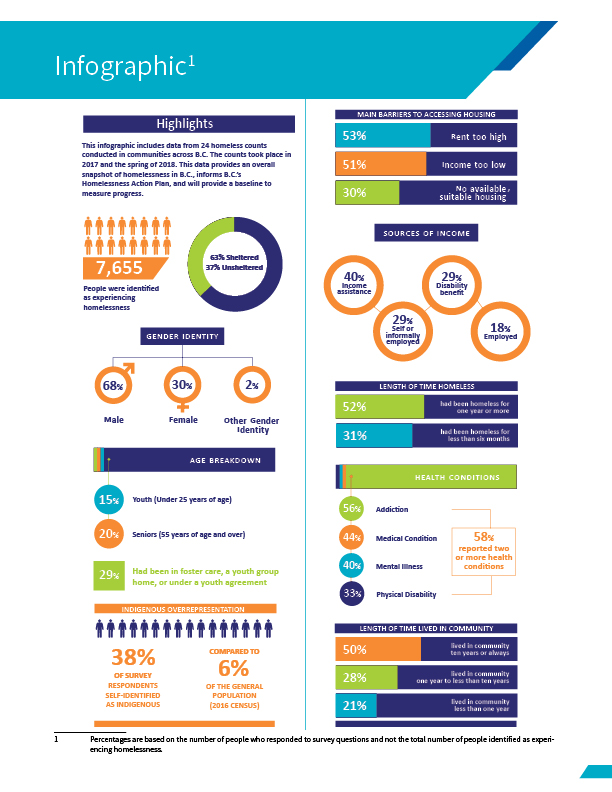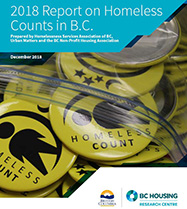2018 Report on Homeless Counts in B.C.
In spring of 2018, the Province of British Columbia funded homeless counts in 12 B.C. communities. HSABC, Urban Matters and the BC Non-profit Housing Association coordinated these counts and combined the results with available data from 12 additional counts and shelters to prepare this report.
- 12 homeless counts funded by the provincial government (March/April 2018)
- Six homeless counts funded by the federal government through the Homelessness Partnering Strategy and two independent homeless counts (March/April 2018)
- Four additional counts (2017)
- Shelter data from other B.C. communities (collected by BC Housing)
What is the Homeless Count?
The 2018 Report on Homeless Counts in B.C. provides important baseline information on the estimated number, key demographic and service provision needs of people experiencing homelessness in communities across B.C.
A Point in Time (PiT) count provides a snapshot of people who are experiencing homelessness in a 24-hour period. For the purpose of the 2018 homeless counts conducted in the 12 provincially funded B.C. communities, an individual was defined as experiencing homelessness if they do not have a place of their own where they pay rent and can expect to stay for at least 30 days.
Findings from the Homeless Count

Total Number of Individuals Experiencing Homelessness
A total of 7,655 individuals were identified as experiencing homelessness in the 2018 Report on Homeless Counts in B.C. This included 219 children who were under the age of 19 and accompanied by a parent or guardian. The majority were sheltered (63%) and 37% were unsheltered.
Fewer Women Counted
Among those who responded to the survey, 68% identified as male and 30% as female. Two percent (2%) of respondents self-identified a gender identity other than male or female.
Seniors and Youth Experiencing Homelessness
Twenty percent (20%) of all survey respondents were seniors (55+ years of age) and 15% were youth (under 25 years of age).
Twenty-nine percent (29%) of survey respondents reported they had been in foster care, a youth group home, or under a youth agreement. In the Fraser Valley, Prince George, Williams Lake, and Campbell River, more than 40% of respondents reported that they had been in care. Fifty-one percent (51%) of all respondents reported experiencing homelessness for the first time when they were under 25 years of age.
Indigenous People Overrepresented
A total of 1,904 survey respondents identified as Indigenous, representing 38% of all respondents. According to the 2016 Census, Indigenous people accounted for six percent (6%) of B.C.’s total population.3 The proportion of survey respondents identifying as Indigenous was higher for unsheltered (42%) than sheltered respondents (32%).

High Rents, Low Incomes and Lack of Suitable Housing
Options Main Barriers to Accessing Housing
The three main barriers to accessing housing identified by survey respondents were high rents (53%), low incomes (51%), and a lack of available, suitable housing (30%).
Individuals Experiencing Homelessness in Poor Health
More than half of survey respondents (58%) reported two or more health conditions.4 The majority of respondents (56%) reported an addiction, 44% reported a medical condition, 40% reported a mental illness, and 33% reported a physical disability.
Sources of Income
Survey respondents identified a range of income sources. The most commonly reported sources of income identified by survey respondents were income assistance (40%), disability benefits (29%), informal/self employment (29%), and employment (18%). Ten percent (10%) of respondents reported having no income.
History of Homelessness
Nearly one-third of survey respondents (31%) reported being homeless for less than six months, while about half (52%) reported being homeless for one year or more. Sheltered respondents were more likely to have been homeless for less than six months compared to unsheltered respondents (38% vs. 25%). Fifty-eight percent (58%) of unsheltered respondents reported being homeless for a year or more, compared to 45% of sheltered respondents.
Survey respondents were likely to be long term community residents – 31% of respondents had lived in the community where they were surveyed for ten or more years, and an additional 19% had lived there all their lives.

